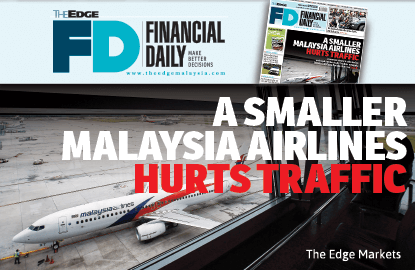
This article first appeared in The Edge Financial Daily, on January 15, 2016.
KUALA LUMPUR: With Malaysia Airlines Bhd taking extreme measures to cut back services in an effort to return the national carrier to profit, airport operator Malaysia Airports Holdings Bhd (MAHB) is bracing to handle less passengers at the 39 airports it manages in the country this year.
MAHB predicts its airports will see a modest passenger traffic growth of 2.5% this year, lower than its forecast of 3% for 2015 and 9.7% for 2014. Last year, passenger traffic came in below expectations, increasing by a marginal 0.5% to 83.73 million from 83.35 million in 2014.
The subdued performance anticipated in 2016 is attributed to the consolidation of Malaysia Airlines’ routes and capacity, with further routes and frequency cuts this year, MAHB told The Edge Financial Daily via email yesterday.
“While other airlines would fill the gap created by Malaysia Airlines, there will be a ramp-up period and we anticipate that growth will start to be seen after the first quarter [of 2016],” it said.
The group said it plans to overcome the tough market conditions expected this year with its aggressive marketing and promotional efforts in collaboration with Tourism Malaysia and various state governments.
“In addition, we have finalised our five-year business plan for the 2016 to 2020 period [called] Runway to Success 2020, which we will unveil at the end of this month.
“Our priorities moving forward, as identified in this plan, will not only be on [the] core airport business, but will allow us to grow our non-aeronautical revenues, especially with the development of the airport city (KLIA Aeropolis) in Sepang,” it added.
MAHB also said there are ongoing discussions to bring in new airlines to serve Langkawi, Kedah, in an effort to boost the island as a tourist destination.
“There are also plans by the existing operators to introduce new destinations and frequencies, which will be announced in due course by the respective airlines,” said MAHB.
Hong Leong Investment Bank Bhd aviation analyst Daniel Wong said the likelihood of the group meeting the 2.5% growth target will depend on Malaysia Airlines’ restructuring exercise.
“The [2.5% growth] projection is conservative. It all depends on how Malaysia Airlines will fare because at the end of the day, the airline controls 33% of the Malaysian air travel market,” he told The Edge Financial Daily.
Malaysia Airlines has cut its capacity by 30% to date.
“Of course, the gap [left by Malaysia Airlines] can be filled by other airlines, such as China Airlines, Emirates and British Airways, which have increased their connectivity to Malaysia, but this takes time,” said Wong.
As such, he is of the view that passenger numbers passing through the 39 airports in the first half of 2016 (1H16) will be lower than the year-ago period, due to last year’s high base, as Malaysia Airlines only cut its capacity in 2H15.
Nevertheless, Wong said based on AirAsia Bhd’s planned fleet increase, passenger traffic growth for 2016 will remain “healthy”, projecting a higher growth rate of 3% to 5% than MAHB’s 2.5% target.
“If you look at demand for AirAsia’s services, it seems to be improving in a way that its passenger load factor has improved to over 80%,” he said.
“This year, the low-cost carrier is adding three more aircraft to its current fleet of 80 airplanes, which is also a conservative projection for AirAsia itself,” he added.
Wong also said the government had allocated RM1.2 billion to the tourism and culture ministry to promote the tourism industry this year.
“This is four times the budget allocated last year [for tourism promotional activities], but of course, it will take time [to attract tourists following the twin tragedies involving Malaysia Airlines in 2014],” he said.
“So for 1H16, you will see some slowdown, but you will be able to see the positive impacts from the promotional activities from 2H16,” he added.
Another analyst at a local firm said MAHB’s growth target of 2.5% this year is achievable when compared with global international passenger traffic growth.
“Compared with regional numbers, it is very modest,” the analyst said.
He added that the weaker ringgit will boost domestic travel, which will partly anchor growth in passenger traffic across MAHB’s airports this year.
Against the backdrop of tumultuous Chinese markets, falling crude oil prices and a weakening ringgit, Khazanah Nasional Bhd had already warned that 2016 will be another volatile year, following disappointing data in 2015. The country’s sovereign wealth fund saw its net worth adjusted of its investment portfolio — a measure of value created — fall 1.6% to RM109 billion from RM110.7 billion the previous year, partly due to the weak ringgit and declines in investment sectors.
Malaysia is also set to announce a revised Budget 2016 on Jan 28, as oil prices fall to the US$30 (RM131.70) per barrel mark from the initial US$48 per barrel assumption, when the budget was first tabled in October last year.
The World Bank has also cut its forecast for global growth this year to 2.9% from an earlier projection of 3.3%.